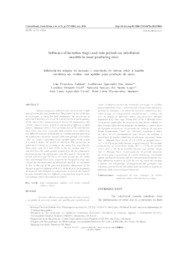Influence of lactation stages and rain periods on subclinical mastitis in meat producing ewes.
Influence of lactation stages and rain periods on subclinical mastitis in meat producing ewes.
Author(s): ZAFALON, L. F.; FIM JUNIOR, G. A.; VASO, C. O.; LOPES, N. S. dos S.; VESCHI, J. L. A.; SANTANA, R. C. M.
Summary: Mastitis negatively influences the survival and weight gain of ovines for meat production. The purpose of this study was to investigate, in sheep for meat production, the occurrence of subclinical mastitis in ewes at the end of lactation and beginning of the consecutive lactation and to assess the composition and cellular characteristics of milk as a function of different rainfall indices. Mammary halves (821) of Santa Ines (479) and Morada Nova (342) ewes were examined. Milk samples were collected in two different moments of lactation: at weaning and postpartum of the consecutive lactation. Sample collection periods were called ?dry? or ?rainy? according to the rainfall index in the month immediately before the month of collection. The occurrence of subclinical mastitis at weaning in the Santa Ines and Morada Nova ewes were 16.4 and 12.6% in the dry period, and 17.7 and 23.5% in the rainy period, respectively. In the consecutive lactation period, the occurrences were 26.7 and 27.7% in the dry period and 41.8 and 39.1% in the rainy period, for the Santa Ines and Morada Nova ewes, respectively. Postpartum stage was critical for the occurrence of subclinical mastitis, as compared to that at the end of the previous lactation. Occurrence of the disease negatively influenced the SCC in the milk at the beginning of lactation and changed its composition, mainly in the rainiest periods, probably due to a difficulty in maintaining hygiene in the environment where the animals remained.
Publication year: 2016
Types of publication: Journal article
Keywords: Ovelha, Rainfall indices, milk composition, sheep, somatic cell count
Observation
Some of Embrapa's publications are published as ePub files. To read them, use or download one of the following free software options to your computer or mobile device. Android: Google Play Books; IOS: iBooks; Windows and Linux: Calibre.
Access other publications
Access the Agricultural Research Database (BDPA) to consult Embrapa's full library collection and records.
Visit Embrapa Bookstore to purchase books and other publications sold by Embrapa.

